The discussion around the optimal software development team structure is more relevant than ever. Rapid technological advancements, the shift towards remote and hybrid work models, increased project complexity, and the demand for faster delivery all highlight the need for efficient team structures. These structures define how team members collaborate and set the pace for the project’s lifecycle. The way a team is assembled and organized is crucial not only to the project’s success but also to the overall success of the business. This article dives deep into different software development team structures to help you determine what works best for your specific needs.
The composition and structure of a development team
Development teams are the driving force that transforms your application ideas into reality. The size of these teams varies based on the project’s timeline, complexity, and the specific expertise required, whether for a single project or multiple concurrent projects.
Key roles in a software development team
- Project Manager: Oversees project planning, resource allocation, and tracks progress to ensure timely completion.
- Business Analyst: Translates business requirements into detailed technical specifications.
- UI/UX Designers: Design the visual and interactive elements of the user interface to enhance user experience.
Software Developers: Write and implement code to develop the software.
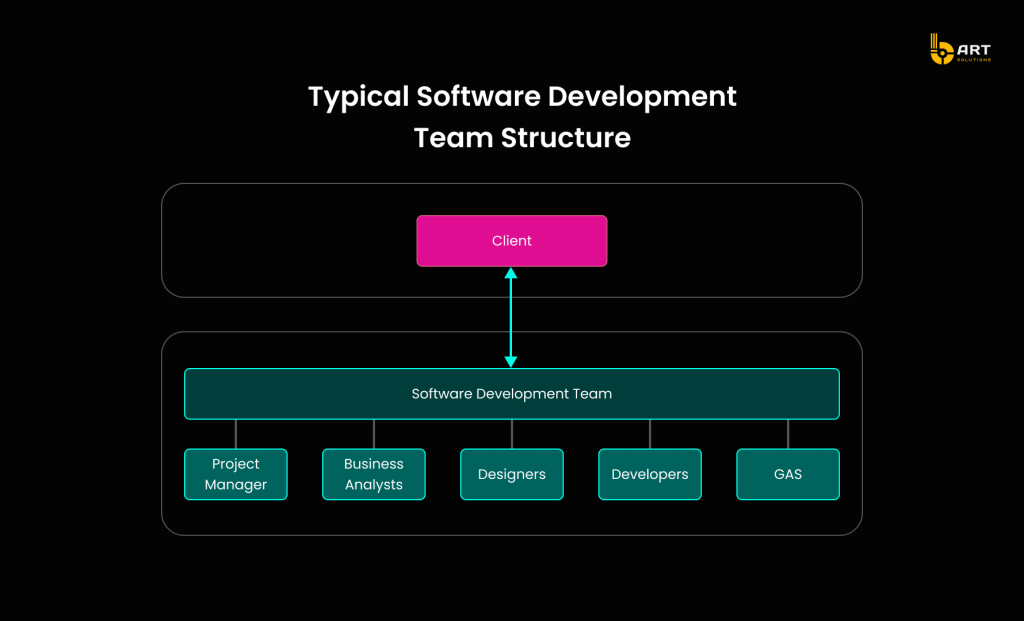
Different approaches to structuring a software development team
There are various approaches to the structure of a software development team, each with its unique strengths and potential drawbacks. Traditional setups adopt a hierarchical structure that ensures clear accountability but may lack flexibility. In contrast, Agile development frameworks revolve around flat structures and cross-functional teams, promoting adaptability but often requiring a significant organizational shift. Hybrid configurations blend the stability of traditional structures with the flexibility of Agile methodologies, but they can be challenging to manage due to their complexity.
The generalist approach
Generalist team members handle a wide range of responsibilities rather than focusing on a single area. These versatile professionals possess a broad skill set, ready to tackle any task that comes their way.
Usually, generalist teams in software development either concentrate on a specific project feature or oversee the entire development cycle. This structure is particularly favored when working with third-party development teams.
Generalist approach pros:
- Flexibility: Generalists can adapt to different tasks, making the team more resilient to changes in project requirements or unforeseen challenges.
- Holistic understanding: With a broad skill set, generalists have a comprehensive view of the project, facilitating better decision-making and problem-solving.
- Reduced dependency: Since each member can perform various tasks, the team isn’t heavily reliant on one person for a specific role or skill.
Generalist approach cons:
- Lack of specialization: While generalists can perform a wide variety of tasks, they might lack the depth of knowledge that specialists possess, potentially impacting the quality of highly specialized tasks.
- Overwhelm: Juggling multiple responsibilities might lead to workload issues, affecting the team members’ focus and productivity.
- Time management: With a broad scope of work, it may be more challenging to manage time and prioritize tasks effectively.
The specialist approach
In contrast to the generalist approach, specialist teams are made up of experts, each bringing a specific skill set to the table. Every member focuses on tasks within their area of expertise.
This approach is ideal for complex projects where top-notch performance is essential and any misstep could be costly. By choosing the specialist approach, you ensure that every challenge is addressed by an expert, minimizing the risk of issues slipping through the cracks.
Specialist approach pros:
- Expert quality: Specialists bring a depth of knowledge and experience to their specific area, leading to high-quality outputs and expert problem-solving.
- Efficiency: As experts in their field, specialists can complete tasks more quickly and accurately, optimizing productivity.
- Less training required: Since specialists already have expertise in their area, they require less training, saving time and resources.
Specialist approach cons:
- Limited flexibility: Specialists might struggle to adapt to tasks outside of their area of expertise, limiting the team’s flexibility.
- Dependency: The team could rely heavily on a specific individual for particular tasks or skills, potentially creating bottlenecks.
- Cost: Hiring specialists can be more expensive due to their high level of expertise and demand in the market.
The hybrid approach
The hybrid approach blends the strengths of both the generalist and specialist strategies. Hybrid teams work on the project in its entirety but can switch gears to apply their unique expertise when necessary. This versatile mix allows for confident and effective handling of any Agile project.
Hybrid approach pros:
- Balanced expertise: Hybrid teams enjoy the best of both worlds, combining generalists’ flexibility with specialists’ deep knowledge.
- Adaptability: They can respond effectively to a broad range of project needs, making them highly adaptable.
- Increased creativity: The diverse skill set in hybrid teams often leads to innovative solutions and creative problem-solving.
Hybrid approach cons:
- Team dynamics: Balancing the strengths and weaknesses of generalists and specialists can be challenging, potentially impacting team dynamics.
- Role confusion: Without clear role definitions, there could be confusion about responsibilities, leading to overlaps or gaps.
- Management complexity: Managing a hybrid team can be more complex due to the diverse skill sets and varying work styles of team members.
Agile vs. traditional team structures: finding the best fit for your project
Agile and traditional structures are not methodologies per se; they are sets of principles and values that guide how teams should be managed to achieve desired outcomes.
Agile Manifesto revolves around the four core principles of Agile project management.
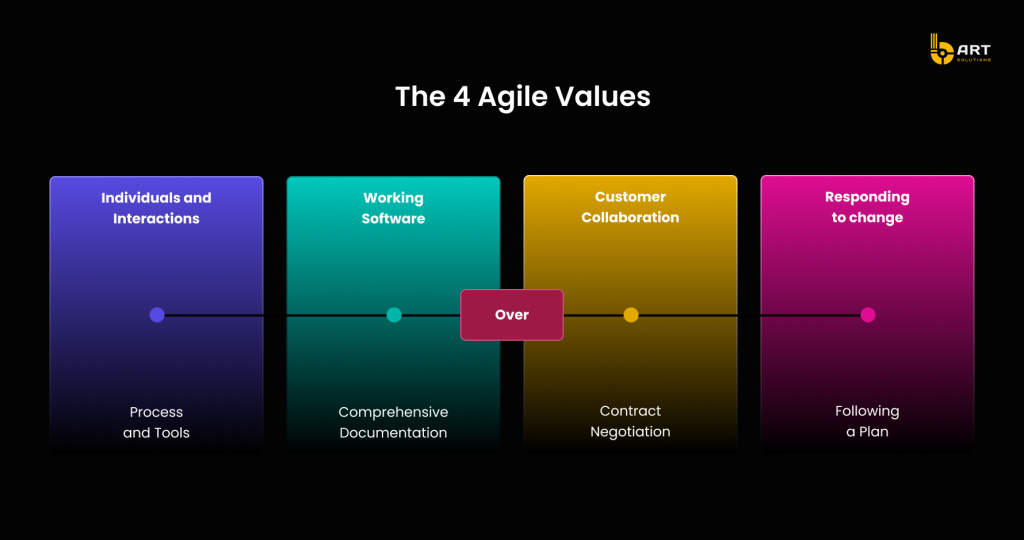
How Agile outshines other methodologies in stats
Agile boasts a success rate in the 80th percentile, making it 1.5 times more effective than models like Waterfall and Iterative. According to recent surveys, 4 out of 5 respondents indicate that their organization favors Agile.
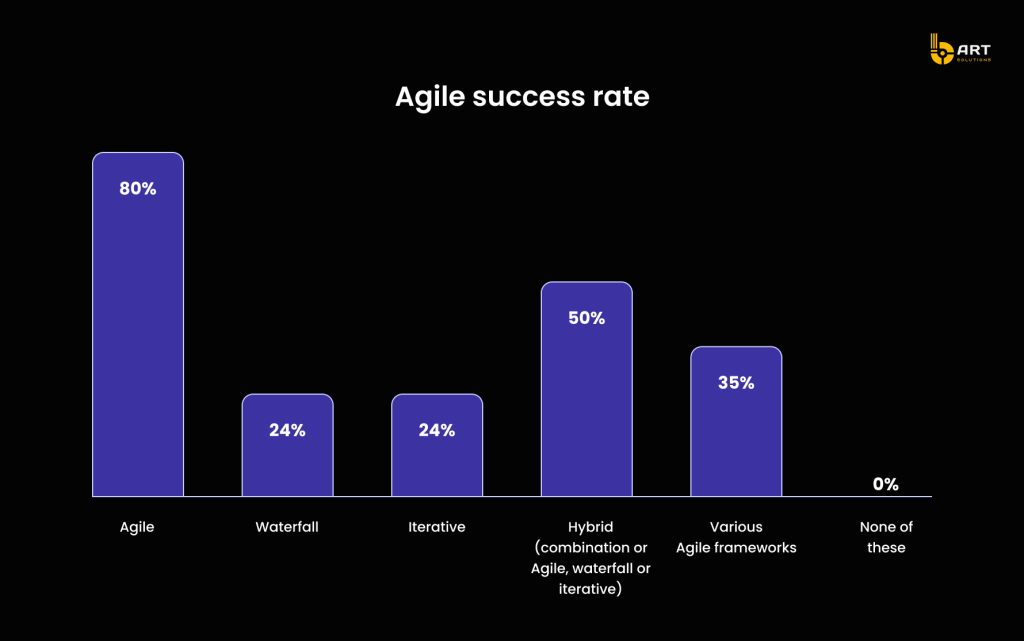
The impact of Agile on revenue and profit growth
The agile approach has proven to be a game-changer, with 60% of companies reporting increased revenue and profits. When implemented effectively, Agile practices offer significant benefits to both individuals and the organization as a whole.
In addition to financial gains, 52% of companies are now adopting Agile to accelerate their time to market.
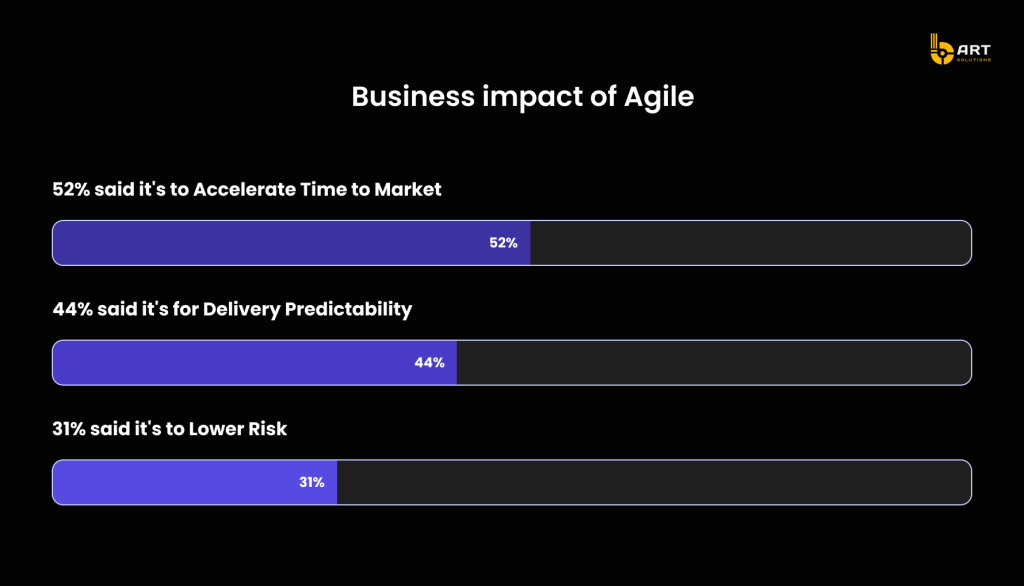
Organizational excellence due to Agile transformation
The success of Agile transformation hinges on a positive and simultaneous shift in organizational culture. Many companies recognize this and adjust their top-level goals to support this change. In fact, 76% of organizations aim for productivity improvement, and 70% prioritize predictability and transparency as key objectives in their agile transformation efforts.
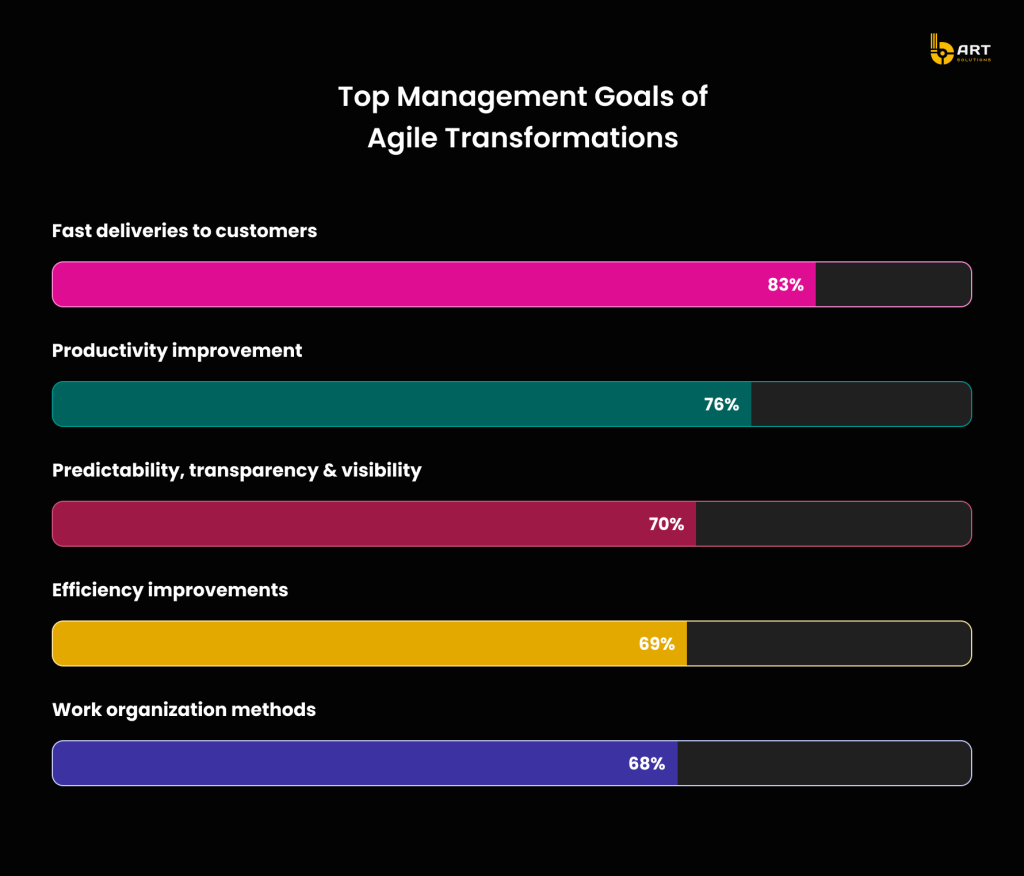
Comparing Agile and traditional development team structures
While traditional teams operate within a hierarchical structure with clear lines of command, Agile teams thrive on collaboration and self-management. In an Agile development team, decisions are made collectively, encouraging members to learn from each other and expand their skill sets.
Traditional teams typically work in distinct phases, such as analysis, design, coding, and testing, completing each step before moving on to the next. Conversely, Agile teams work in sprints, with all stages occurring simultaneously within each sprint. Iterative approach allows to deliver workable products faster and adapt more readily to changes.
In summary, the Agile software engineering team structure focuses less on rigid roles and more on flexible collaboration. This approach breaks down silos, promotes adaptability to change, fosters innovation, accelerates delivery speed, and ultimately enhances customer satisfaction.
The main differences between Agile and traditional team structures are highlighted in the table below:

Tips on structuring a software development team

Here are some tips on how to effectively arrange a software development team for your project.
1. Decide on the size of the team
The size of your software development team significantly impacts development time, costs, resource allocation, and overall management. Typically, development teams are kept relatively small. Even larger teams are often divided into smaller sub-teams to maximize efficiency.
Small software development teams offer numerous benefits:
- Fewer organizational and workflow issues: Smaller teams experience fewer complications related to structure and processes.
- Dynamic and flexible: They can be easily structured and restructured as needed.
- Independence: Smaller teams often work more autonomously.
- Easier communication: Coordinating efforts and maintaining clear communication is simpler with fewer members.
It’s essential to define what a small team means for your specific use case. For example, Jeff Bezos, the CEO of Amazon, suggests that if a team cannot be fed with two pizzas, it’s too large. Generally, limiting your team size to 5-7 members can enhance productivity. For larger groups, consider splitting them into smaller, manageable sub-teams.
2. Split big teams into smaller ones
Managing large development teams can be challenging but dividing them into smaller units can help. Here’s how you can do it:
- By specialization: Create teams based on specific skills like design, front-end development, back-end development, etc.
- By roles: Form teams that include a mix of roles, such as a project manager, designer, and developers, to cover the entire development cycle.
- By development stages: Structure teams according to different phases of the project, ensuring each stage has the necessary expertise.
Keep in mind that more teams require more coordination and supervision, so plan accordingly.
3. Decide who you need for the project
Strive to keep your teams balanced with the right mix of specialists to cover all aspects of development. A typical full-cycle software development team might include:
- 1 UI/UX Designer (or separate UI and UX designers if necessary)
- 1-2 Front-End Developers (or Mobile Developers for app development)
- 1-2 Back-End Developers
- 1 QA Expert
- 1 Project Manager
Agile team structure can vary depending on your specific project needs. Additionally, pay attention to team roles, which might not always align with job titles. For instance, a team lead might be any member with the necessary skills to guide a team, not just a project manager or senior developer.
If your team structure isn’t too complex, a single team lead may suffice. For larger setups, a chief architect may be necessary to coordinate all teams, align on product architecture, and oversee the overall technical development process.
4. Feel free to change up the teams
Don’t hesitate to restructure your software teams as needed. This could be on a temporary basis (e.g., for code reviews) or a permanent one. Regularly rotating team members can be beneficial in various situations like:
- Starting a new project
- Adjusting to changes in team size
- Addressing tasks that a sub-team cannot solve
- Improving team performance
- Meeting specific project needs
Assign people to projects that match their interests to leverage their initiative and experience.
5. Make the workspace friendly
Creating a friendly and inclusive atmosphere is crucial for the productivity of software development teams. It’s important to ensure:
- Everyone has a voice: Encourage open communication and value each team member’s input.
- Mutual respect: Foster an environment where team members respect and support each other.
- Issues are addressed promptly: Deal with any problems quickly to maintain a positive work environment.
Opting for an Agile software development team is a smart long-term strategy, as it reduces both development time and costs while maintaining high quality. Agile teams deliver faster and more efficient results.
Benefits of adopting Agile development for a software project

At bART Solutions, we view the Agile approach as one of our core values, providing numerous advantages for both our clients and our team. Here are some of the key benefits:
Enhanced collaboration
Agile methodologies foster self-organized teams that work together in a collaborative and transparent manner. This environment encourages better design practices, improved product quality, and the adoption of best practices throughout the development process.
Continuous delivery
Agile teams focus on the timely and continuous delivery of software features, which ensures enhanced customer satisfaction. Unlike traditional methods, agile teams do not need a complete idea of the end product from the start. Instead, they concentrate on delivering high-quality software within the stipulated time frame that meets customer expectations.
Adaptability to changing requirements
One of the standout features of agile development is its flexibility in handling changing requirements. Customers can request modifications to functionality even at the last moment, and the team can accommodate these changes due to the iterative nature of agile workflows.
Improved product quality
Agile methods have been shown to significantly enhance product quality. Studies estimate that projects using agile methodologies see a 42% improvement in product quality compared to traditional methods. This leads to a final product that closely aligns with customer requirements and expectations.
Quicker time to market
Agile teams work closely with other teams and customers, making the development process extremely efficient. The use of fixed-schedule sprints allows for frequent and swift delivery of new features, resulting in a quicker time to market.
Flexibility and responsiveness
Agile development breaks down the project into smaller components, each handled by different teams. This approach allows for individual testing and delivery of components. If a component does not perform as expected, the team can quickly make modifications, ensuring flexibility and responsiveness to issues.
Reduced overall risk
The phased approach of agile development, with its emphasis on iterations and sprints, significantly reduces the risk of complete project failure. Agile teams can incorporate changes as needed, making it easier to adapt the product to evolving client needs and minimizing the chances of software failure.
Conclusion
Choosing the right structure for your software development team is a critical decision that can significantly impact your project’s success and overall business performance. Whether you opt for a generalist, specialist, or hybrid approach, or decide between Agile and traditional methodologies, the key is to tailor the team structure to fit the specific needs and goals of your project.
The success of your software development project ultimately hinges on the people who bring your vision to life. Contact us for a team with a balanced mix of skills and roles, capable of delivering exceptional results.
